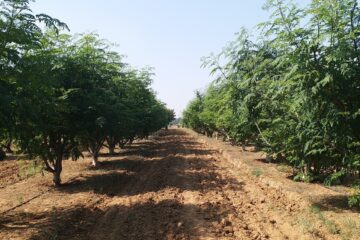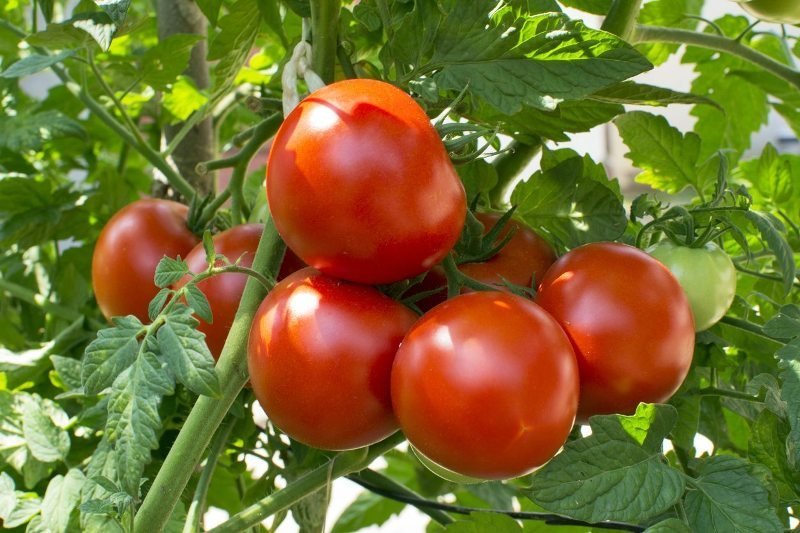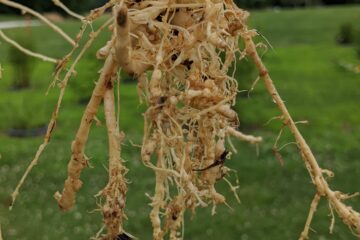Pulses, like black gram and green gram, are rich sources of plant protein and are often called “poor man’s meat.” They play a key role in providing food, improving soil fertility, preventing soil erosion, and serving as excellent fodder for livestock. However, these crops are vulnerable to several diseases that can reduce their yield. Here’s an overview of the main diseases affecting black gram and green gram, along with control measures.
In Tamil Nadu, pulses are cultivated on 880,000 hectares, yielding about 760,000 tons with an average productivity of 867 kg per hectare. This is slightly lower than the global average of 903 kg per hectare. Diseases such as root rot, powdery mildew, and yellow mosaic are common and significantly impact pulse productivity.
Root Rot – Macrophomina phaseolina
This disease causes severe damage, often affecting patches or the entire crop area. Infected plants typically die within 7-10 days. Uprooting an infected plant reveals rotting roots with peeling bark and black spots on exposed tissues. Stems may appear as if covered in a silvery layer. If this disease strikes during flowering, pods may shrivel, reducing both weight and protein content. Root rot spreads through soil, seeds, air, and water.
Control Measures:
- Treat seeds with 4g Trichoderma viride, 10g Pseudomonas fluorescens, or 2g carbendazim per kg of seeds.
- Apply a mixture of 2.5 kg each of Trichoderma viride and Pseudomonas fluorescens with 50 kg decomposed manure at sowing and 30 days after sowing.
- For affected areas, use 1g of carbendazim per liter of water and pour it onto the affected spot.
Powdery Mildew – Erysiphe polygoni
Powdery mildew affects leaves, petioles, stems, flower clusters, buds, and pods. Infected leaves develop white powdery patches that eventually turn brown or black, leading to wilting and shedding. The disease is spread through infected leaves and airborne spores.
Control Measures:
- Spray 5% neem seed extract or 3% neem oil twice, 10 days apart.
- Alternatively, use 250g of carbendazim, 250g of wettable sulfur, or 250 ml of propiconazole per acre.
Leaf Spot – Cercospora canescens
This disease appears as small, circular spots on leaves with a grayish center and brown edges. As the spots merge, the entire leaf dries and falls off. It spreads through airborne spores from infected plants.
Control Measures:
- Spray 500g of mancozeb, 250g of chlorothalonil, or 200 ml of propiconazole per acre.
Anthracnose – Colletotrichum lindemuthianum
Infected plants develop large spots, particularly on leaves, with gray centers and brown edges. The disease affects all parts of the plant except the roots. It can result in dark red spots on young leaves, eventually causing them to dry and fall off. In severe cases, pods and seeds turn dark, reducing quality. The disease spreads through spores carried by the wind from infected plants.
Control Measures:
- Spray 500g of mancozeb or 250 ml of propiconazole per acre.
Rust – Uromyces phaseoli
Rust disease, if it strikes young plants, can lead to substantial losses. Within 8-10 days of infection, orange rust pustules appear on both surfaces of leaves. These pustules develop into reddish-brown spots within 48 hours, causing leaves to curl, dry, and fall off, significantly reducing yield.
Control Measures:
- Remove and destroy infected parts of the plant.
- Spray 500g of mancozeb or 250 ml of propiconazole per acre at the first sign of infection.
Yellow Mosaic Virus
Yellow mosaic virus begins with small yellow spots on young leaves, eventually spreading to the entire leaf, creating irregular yellow and green patterns. Infected plants grow slowly, bear fewer pods, and sometimes produce yellow, shriveled seeds. The virus spreads through whiteflies.
Control Measures:
- Use disease-resistant varieties such as VBN 6, 7, and 8 for black gram, and CO-8 and PUSA-9 for green gram.
- Remove and destroy infected plants.
- Place five yellow sticky traps per acre to capture whiteflies.
- Treat seeds with 5 ml of imidacloprid per kg of seeds, and spray 80 ml of imidacloprid per acre during crop growth.
Regularly rotate fungicides to prevent resistance buildup and effectively control these diseases.
P. Narayanan, Crop Protection Specialist, Agricultural Science Center, Kilnelli, Tiruvannamalai – 604 410.










